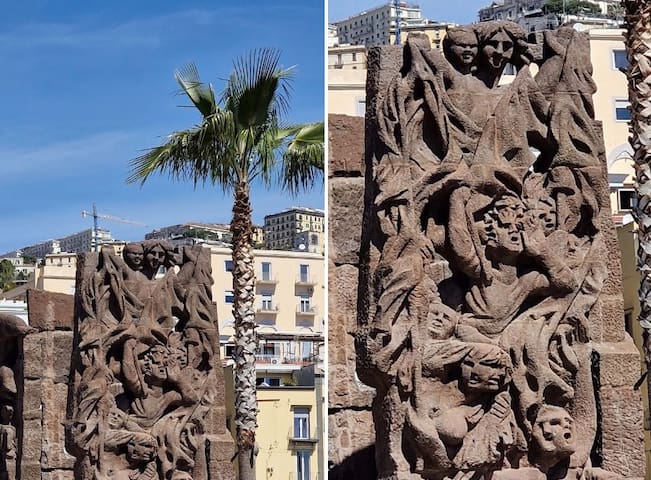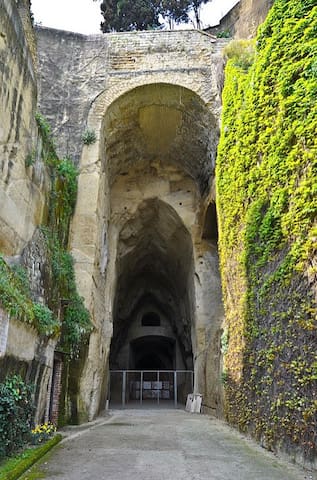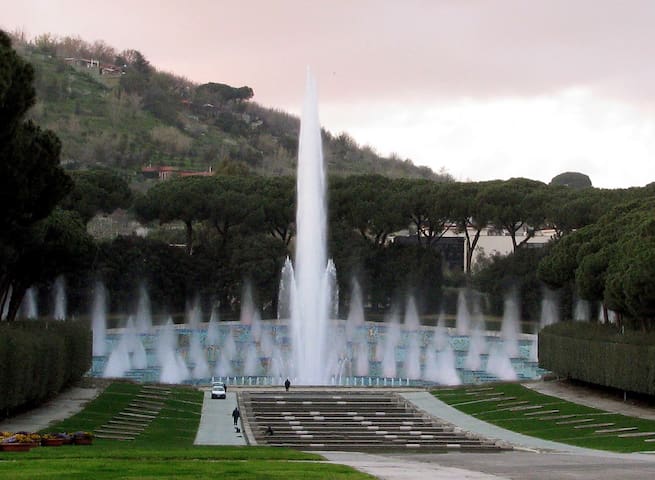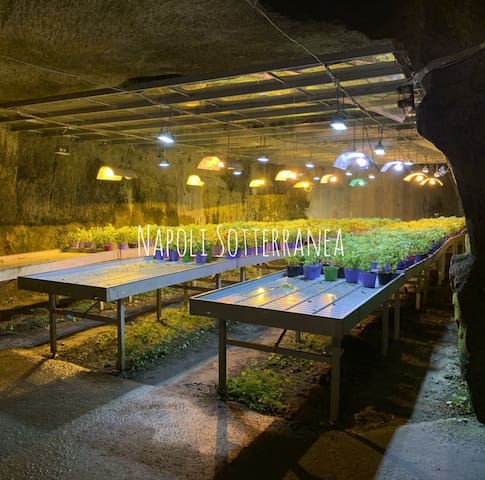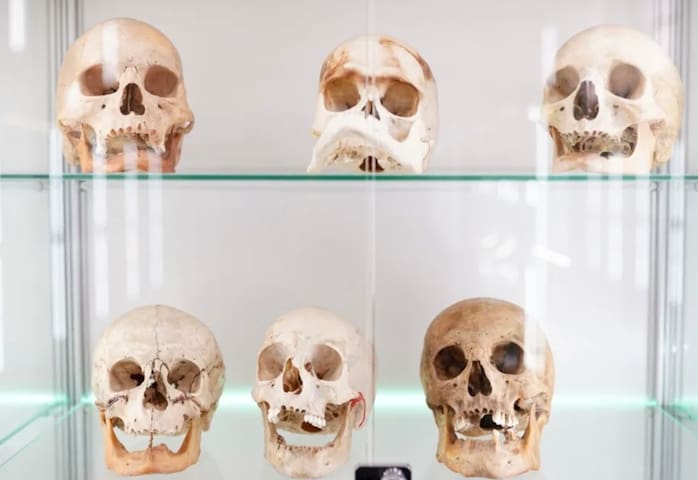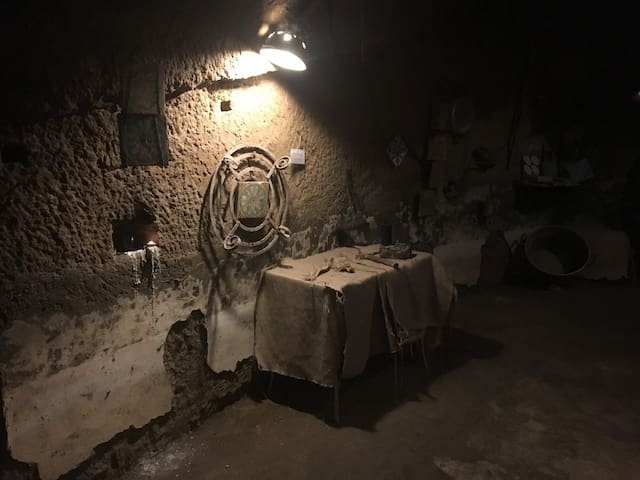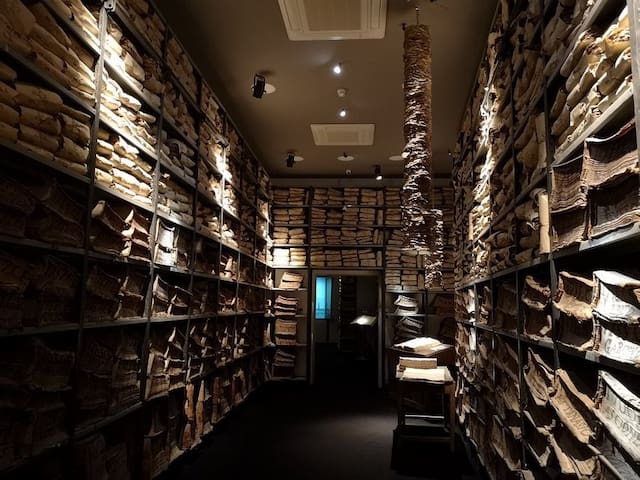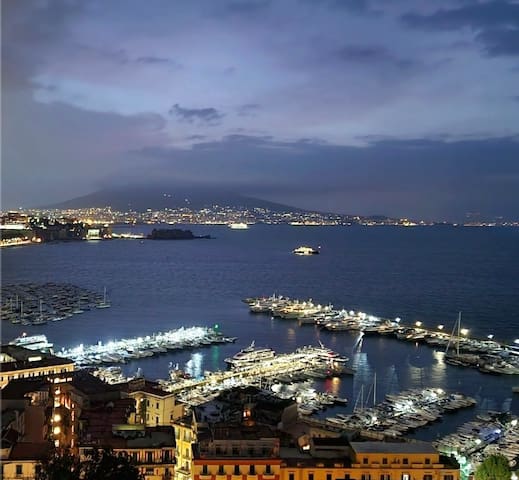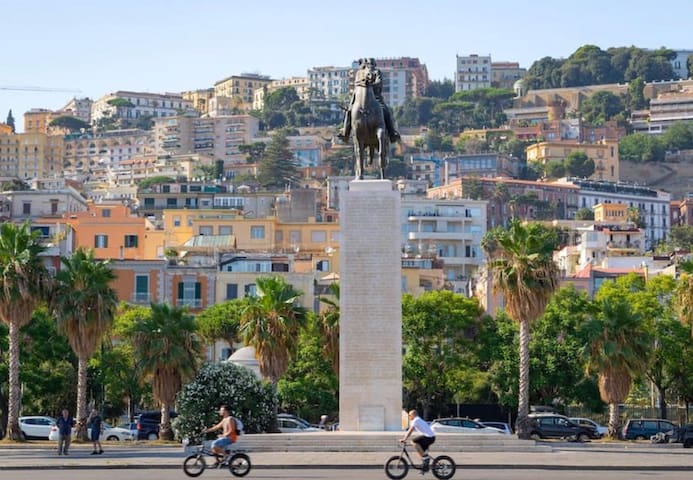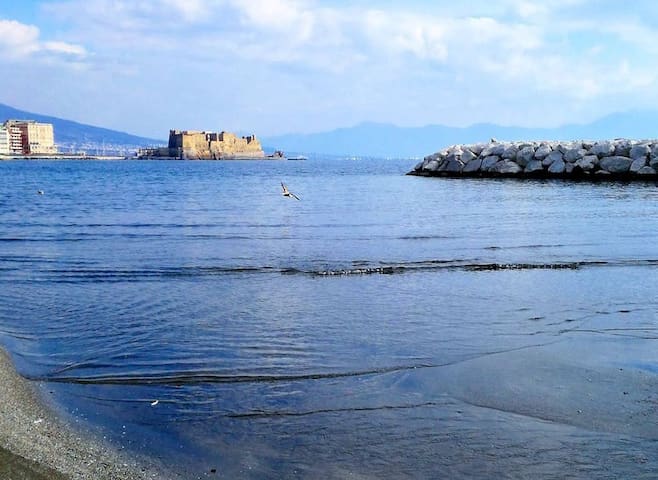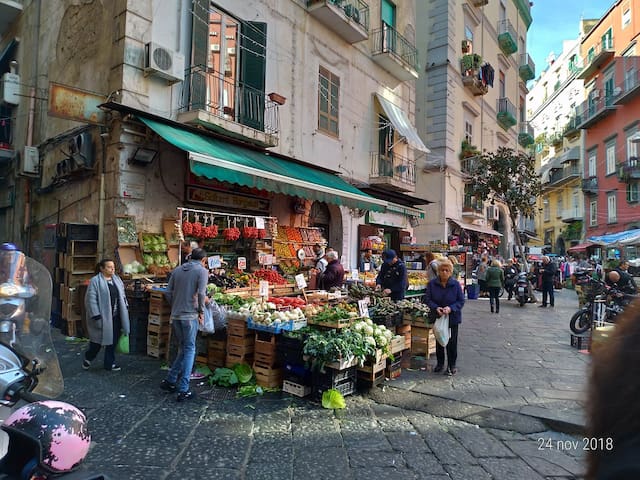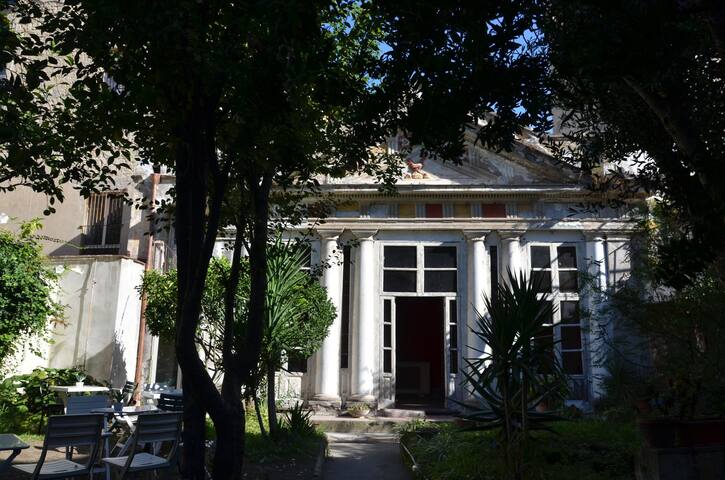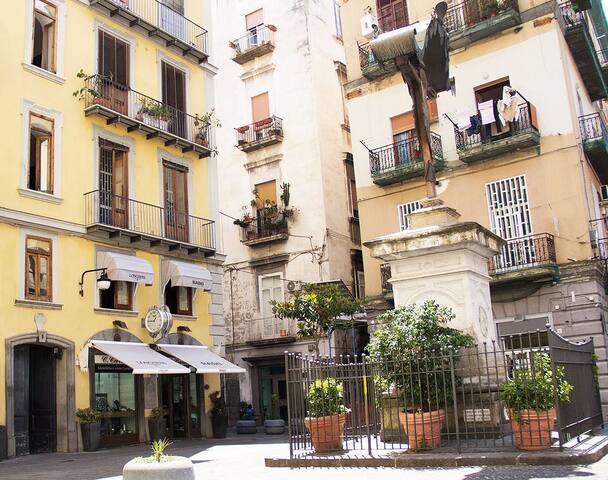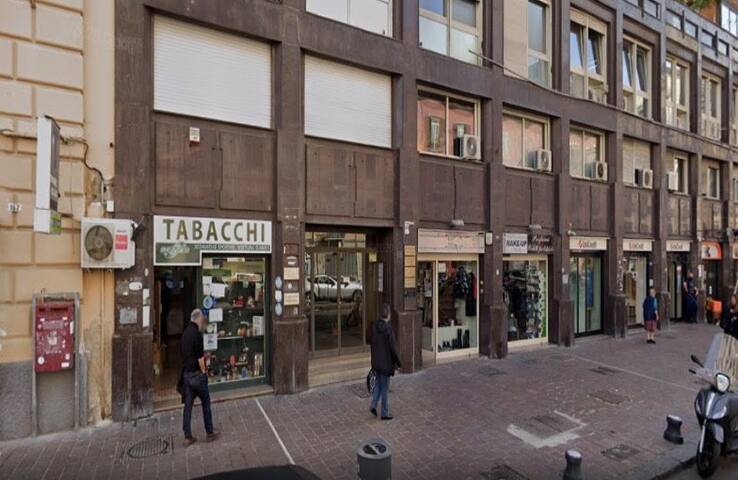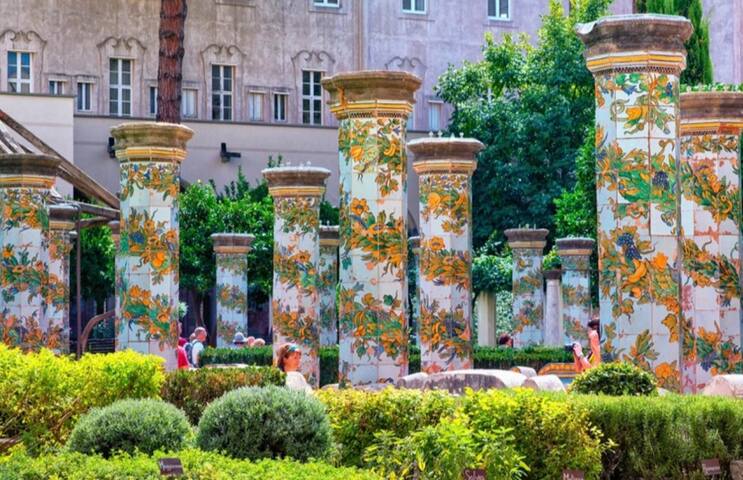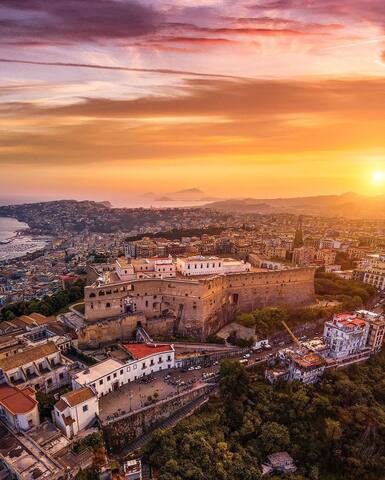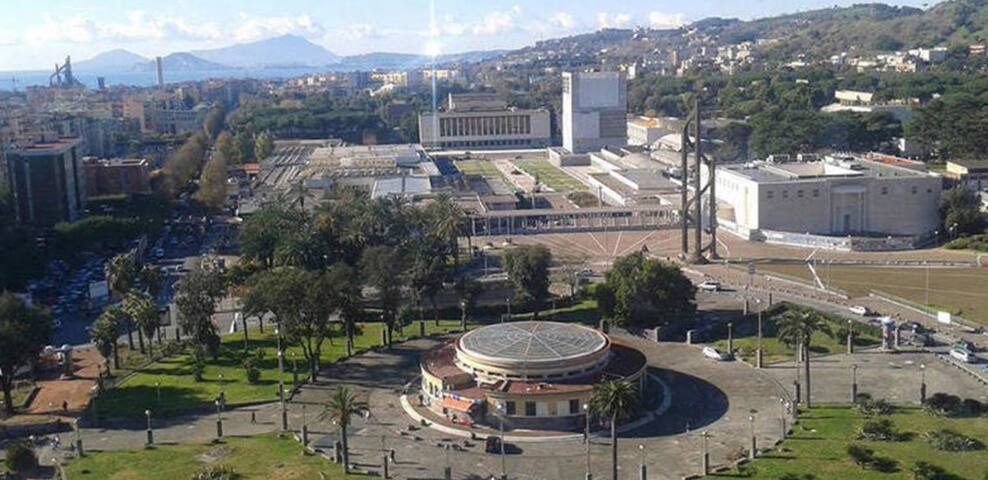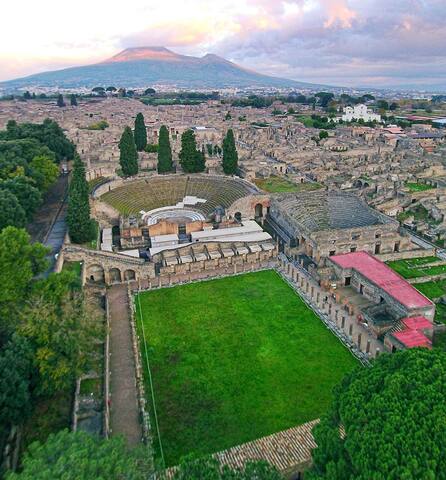Napoli Capri Ischia Procida Pompei Costiera Amalfitana Penisola Sorrentina
Apartments Hotel Real Suite
Food scene of Napoli
A hidden gem, find fresh fruits and vegetables vendors to home gadgets shops and a supermarket, also a restaurant where nonna cooks, all in one comfortable hall, really authentic
Torretta Market
25-33 Via Ferdinando GalianiA hidden gem, find fresh fruits and vegetables vendors to home gadgets shops and a supermarket, also a restaurant where nonna cooks, all in one comfortable hall, really authentic
Dinner with a phenomenal view in Marechiaro. If you are in two I advice my favourite order
- Sauté vongole (one to share in two)
- Linguine all'Astice (the classic recipe [main course])
- Greco di Tufo di Villa Matilde (one bottle in two)
- crostata di limone (dessert)
this way everything you should pay less than 100 euros (then if you are happy of your personal waiter we use to tips them in cash)
44 personas del lugar lo recomiendan
CICCIOTTO dal 1942
32 Calata Ponticello a MarechiaroDinner with a phenomenal view in Marechiaro. If you are in two I advice my favourite order
- Sauté vongole (one to share in two)
- Linguine all'Astice (the classic recipe [main course])
- Greco di Tufo di Villa Matilde (one bottle in two)
- crostata di limone (dessert)
this way everything you should pay less than 100 euros (then if you are happy of your personal waiter we use to tips them in cash)
Not go for pizza, but traditional Neapolitan food. If you are in two I advice my favourite is "Zizzone mozzarella" with "Melanzane a funghetto". Then if you are still hungry maybe try one "Pasta alla Genovese " and "Carne alla Genovese" then if you drink water the bill will be fair
37 personas del lugar lo recomiendan
Mattozzi Restaurant & Pizzeria
16 Via Gaetano FilangieriNot go for pizza, but traditional Neapolitan food. If you are in two I advice my favourite is "Zizzone mozzarella" with "Melanzane a funghetto". Then if you are still hungry maybe try one "Pasta alla Genovese " and "Carne alla Genovese" then if you drink water the bill will be fair
If you go for a quick lunch and you find too crowded maybe ask for take away (remember them to cut in slices) and maybe eat it in the streets with a Peroni beer. This antica pizzeria does only the real pizzas which are Margherita or Marinara only. No other flavours
406 personas del lugar lo recomiendan
Pizzeria Da Michele
1 Via Cesare SersaleIf you go for a quick lunch and you find too crowded maybe ask for take away (remember them to cut in slices) and maybe eat it in the streets with a Peroni beer. This antica pizzeria does only the real pizzas which are Margherita or Marinara only. No other flavours
La Masardona
27 Via Giulio Cesare CapaccioPizza fritta (fried pizza) since 1945
SAPORI & DINTORNI STORE
8 Via AlabardieriGourmet Supermarket (Luxury)
Folklore in the heart of Quartieri Spagnoli. Cheap and fun. Crowded so better arrive by walk with public transportation
368 personas del lugar lo recomiendan
Trattoria da Nennella
22 Vico Lungo Teatro NuovoFolklore in the heart of Quartieri Spagnoli. Cheap and fun. Crowded so better arrive by walk with public transportation
Super good pastry making also gelato graffa and everything you can imagine from Neapolitan pastry art cuisine
76 personas del lugar lo recomiendan
Chalet Ciro Gelato
Via OrazioSuper good pastry making also gelato graffa and everything you can imagine from Neapolitan pastry art cuisine
50 Kalò
201 Piazza SannazaroVery good gourmet pizza
Monumente 'e Napule
After the restoration and relocation due to the works in piazza della repubblica it is even more valued. In plain sight for those who will leave the new Arco Mirelli - Piazza della Repubblica metro stop
Monumento allo scugnizzo
6 Piazza della RepubblicaAfter the restoration and relocation due to the works in piazza della repubblica it is even more valued. In plain sight for those who will leave the new Arco Mirelli - Piazza della Repubblica metro stop
The Crypta Neapolitana is an ancient Roman road tunnel near Naples, Italy. It was built in 37 BC and is over 700 metres long.
The tunnel connected Naples with the so-called Phlegrean Fields and the town of Pozzuoli along the road known as the via Domiziana.
Crypta Neapolitana (lato Fuorigrotta)
Via della Grotta VecchiaThe Crypta Neapolitana is an ancient Roman road tunnel near Naples, Italy. It was built in 37 BC and is over 700 metres long.
The tunnel connected Naples with the so-called Phlegrean Fields and the town of Pozzuoli along the road known as the via Domiziana.
The Mostra d'Oltremare in Naples is one of the primary exhibition and complex in Italy
28 personas del lugar lo recomiendan
Mostra d'Oltremare
54 Viale John Fitzgerald KennedyThe Mostra d'Oltremare in Naples is one of the primary exhibition and complex in Italy
The fountain structure, inspired by the eighteenth-century models of the fountain of the Royal Palace of Caserta
Fontana dell'Esedra
Via Palepoli a FuorigrottaThe fountain structure, inspired by the eighteenth-century models of the fountain of the Royal Palace of Caserta
The Cappella Sansevero is a chapel located on Via Francesco de Sanctis 19, just northwest of the church of San Domenico Maggiore, in the historic center of Naples, Italy. The chapel is more properly named the Chapel of Santa Maria della Pietà.
Visit Art works like
- Pudicizia (1752) Antonio Corradini,
- Veiled Christ (1753) Giuseppe Sanmartino
1008 personas del lugar lo recomiendan
Museo Cappella Sansevero
19/21 Via Francesco de SanctisThe Cappella Sansevero is a chapel located on Via Francesco de Sanctis 19, just northwest of the church of San Domenico Maggiore, in the historic center of Naples, Italy. The chapel is more properly named the Chapel of Santa Maria della Pietà.
Visit Art works like
- Pudicizia (1752) Antonio Corradini,
- Veiled Christ (1753) Giuseppe Sanmartino
Gesù Nuovo
2 Piazza del Gesù Nuovoroom Al Cristo Velato
20 Via NiloVeiled Christ (Cristo velato)
Nápoles Subterránea
68 Piazza San GaetanoNapoli Sotterranea
Spaccanapoli
Via dei TribunaliSpaccanapoli
MUSA Anatomy Museum - Naples is home to one of Italy’s most eccentric anatomy museums. The museum is packed with ancient Roman medical tools, anatomical sculptures made from wax, and mutated specimens preserved in formaldehyde. You’ll also find the skulls of victims who died when Mount Vesuvius erupted in Pompeii in 79 A.D. This museum is the perfect hidden gem in Naples to wander through with the whole family. You’ll be able to learn about the processes of cremation and fossilization; the evolution of medical equipment and the modernization of Neapolitan hospitals; and the cultivation of studies in physiology and pharmacology.
Via Luciano Armanni, 5
5 Via Luciano ArmanniMUSA Anatomy Museum - Naples is home to one of Italy’s most eccentric anatomy museums. The museum is packed with ancient Roman medical tools, anatomical sculptures made from wax, and mutated specimens preserved in formaldehyde. You’ll also find the skulls of victims who died when Mount Vesuvius erupted in Pompeii in 79 A.D. This museum is the perfect hidden gem in Naples to wander through with the whole family. You’ll be able to learn about the processes of cremation and fossilization; the evolution of medical equipment and the modernization of Neapolitan hospitals; and the cultivation of studies in physiology and pharmacology.
You’ll find this gem hidden among the narrow alleys of the city center, near the famous Via dei Presepi. The church’s underground crypt was once used as a burial site. Members of the Neapolitan Cult of the Dead often came here to pray. They often offered prayers especially to the “skull with ears,” hoping this anatomical curiosity would act as a messenger between the worlds of the living and dead. The skull lives up to its name as it has two pieces of mummified cartilage, one on either side, which resembles ears. Look out for it watching over you as you explore.
7 personas del lugar lo recomiendan
Chiesa di Santa Luciella ai Librai
5 Vico Santa LuciellaYou’ll find this gem hidden among the narrow alleys of the city center, near the famous Via dei Presepi. The church’s underground crypt was once used as a burial site. Members of the Neapolitan Cult of the Dead often came here to pray. They often offered prayers especially to the “skull with ears,” hoping this anatomical curiosity would act as a messenger between the worlds of the living and dead. The skull lives up to its name as it has two pieces of mummified cartilage, one on either side, which resembles ears. Look out for it watching over you as you explore.
If you’re a travel buff then you’re not going to want to miss this hidden gem. The National Railway Museum of Pietrarsa is housed in the old Bourbon workshops that were founded in 1840 at the command of Ferdinand II. You’ll be able to uncover the history of railways in Italy from the mid-19th century to today’s high-speed trains. There are lots of locomotives on display and much of the museum is covered, making it perfect if you’re in the area on a rainy day. It lies just to the side of the Naples-Portici railway line – Italy’s first railway line – and is very close to Naples itself.
98 personas del lugar lo recomiendan
Museo Ferroviario de Pietrarsa
snc Via PietrarsaIf you’re a travel buff then you’re not going to want to miss this hidden gem. The National Railway Museum of Pietrarsa is housed in the old Bourbon workshops that were founded in 1840 at the command of Ferdinand II. You’ll be able to uncover the history of railways in Italy from the mid-19th century to today’s high-speed trains. There are lots of locomotives on display and much of the museum is covered, making it perfect if you’re in the area on a rainy day. It lies just to the side of the Naples-Portici railway line – Italy’s first railway line – and is very close to Naples itself.
Catacombe di San Gennaro
13 Via CapodimonteCatacumbas de San Gaudioso
123 Piazza SanitàCatacombe di San Gaudioso
La Neapolis Sotterrata - Complesso Monumentale San Lorenzo Maggiore
106 personas del lugar lo recomiendan
San Lorenzo Maggiore
316 Piazza San GaetanoLa Neapolis Sotterrata - Complesso Monumentale San Lorenzo Maggiore
Gallerie di Palazzo Zevallos Stigliano
58 personas del lugar lo recomiendan
Palacio Zevallos Stigliano
185 Via ToledoGallerie di Palazzo Zevallos Stigliano
Pio Monte della Misericordia
253 Via dei TribunaliPio Monte della Misericordia
Cave of Sejanus
36 Discesa CoroglioGrotta di Seiano
San Giovanni a Carbonara
4 Via CarbonaraLa Chiesa Di San Giovanni A Carbonara
Sant'Anna dei Lombardi (Monteoliveto)
16 personas del lugar lo recomiendan
Complejo monumental de Santa Ana de Lombardi
4 Piazza MonteolivetoSant'Anna dei Lombardi (Monteoliveto)
Miglio Sacro
72 Vico LammatariMiglio Sacro
Chiesa dei Santi Filippo e Giacomo - Complesso Museale dell'Arte della Seta
La Chiesa dell'Arte della Seta - Complesso dei Santi Filippo e Giacomo
118 Via San Biagio dei LibraiChiesa dei Santi Filippo e Giacomo - Complesso Museale dell'Arte della Seta
Pausilypon Archaeological Park
36 Discesa CoroglioParco Archeologico Pausilypon
Monumental Complex Donnaregina - Diocesan Museum of Naples
19 personas del lugar lo recomiendan
Diocesan Museum Naples - Monumental Complex Donnaregina
Largo DonnareginaMonumental Complex Donnaregina - Diocesan Museum of Naples
Palazzo dello Spagnolo
19 Via VerginiPalazzo dello Spagnolo
Complesso Museale Santa Maria delle Anime del Purgatorio ad Arco
36 personas del lugar lo recomiendan
Purgatorio ad Arco
39 Via dei TribunaliComplesso Museale Santa Maria delle Anime del Purgatorio ad Arco
Museo delle Torture
18/B Vico Santa LuciellaMuseo delle Torture
Acquaquiglia del Pozzaro
106 Via FontanelleAcquaquiglia del Pozzaro
Madre · museo d'arte contemporanea Donnaregina
307 personas del lugar lo recomiendan
Museo de Arte Contemporáneo Donnaregina
79 Via Luigi SettembriniMadre · museo d'arte contemporanea Donnaregina
Museo Civico Gaetano Filangieri
288 Via DuomoMuseo Civico Gaetano Filangeri
Basilica di Santa Maria della Sanità
33 Piazza SanitàSanta Maria della Sanita
ilCartastorie - Museo dell'Archivio Storico Banco di Napoli
12 personas del lugar lo recomiendan
ilCartastorie - museo dell'Archivio Storico del Banco di Napoli
214 Via dei TribunaliilCartastorie - Museo dell'Archivio Storico Banco di Napoli
Museo del Corallo
19 Piazzetta Matilde SeraoMuseo del Corallo Ascione
Basilica San Giovanni Maggiore
Rampe San Giovanni MaggioreBasilica di San Giovanni Maggiore
Museum Hermann Nitsch
29 Vico Lungo PontecorvoMuseo Hermann Nitsch
Diomede Carafa Palace
121 Via San Biagio Dei LibraiPalazzo Diomede Carafa
Palazzo delle Arti Nápoles
60 Via dei MilleSightseeing of Napoli
A must for those who want to photograph a "postcard" of the Gulf of Naples. You can visit this place by walking 17minutes from "Affittacamere Real Suite Guest House Naples Chiaia" to "Belvedere di Sant'Antonio a Posillipo" through "Rampe S. Antonio a Posillipo"
17 personas del lugar lo recomiendan
Chiesa di Sant'Antonio a Posillipo
13 Via Minucio FeliceA must for those who want to photograph a "postcard" of the Gulf of Naples. You can visit this place by walking 17minutes from "Affittacamere Real Suite Guest House Naples Chiaia" to "Belvedere di Sant'Antonio a Posillipo" through "Rampe S. Antonio a Posillipo"
Cape Miseno is the headland that marks the northwestern limit of the Gulf of Naples as well as the Bay of Pozzuoli in southern Italy. The cape is directly across from the island of Procida and is named for Misenus, a character in Virgil's Aeneid.
17 personas del lugar lo recomiendan
Cape Miseno
Cape Miseno is the headland that marks the northwestern limit of the Gulf of Naples as well as the Bay of Pozzuoli in southern Italy. The cape is directly across from the island of Procida and is named for Misenus, a character in Virgil's Aeneid.
Gaiola Island is one of the minor islands of Naples, off the city's Posillipo residential quarter, in the Metropolitan City of Naples and Campania region, southwestern Italy. It is located within the "Parco sommerso di Gaiola".
124 personas del lugar lo recomiendan
Área Marina Protegida Parque Subacuático Gaiola
Discesa GaiolaGaiola Island is one of the minor islands of Naples, off the city's Posillipo residential quarter, in the Metropolitan City of Naples and Campania region, southwestern Italy. It is located within the "Parco sommerso di Gaiola".
Quando la guardi dal mare, o dalle terrazze del Parco Virgiliano, la Baia di Trentaremi sembra un luogo esotico e lontano, distaccato da tutto. Dal caos cittadino, dalla calura estiva, dal fragore delle strade di Napoli, sempre in movimento.
Baia Trentaremi
22 Via Tito Lucrezio CaroQuando la guardi dal mare, o dalle terrazze del Parco Virgiliano, la Baia di Trentaremi sembra un luogo esotico e lontano, distaccato da tutto. Dal caos cittadino, dalla calura estiva, dal fragore delle strade di Napoli, sempre in movimento.
Fontana del Sebeto
139 Via MergellinaFontana del Sebeto
Rotonda Diaz
Rotonda DiazRotonda Diaz Napoli
Lido Mappatella - Spiaggia Comunale
Winter view - Lido Mappatella - Spiaggia Comunale
Acquario di Napoli
Castello Aragonese di Baia is an old castle that dominates the entire Bay of Pozzuoli. It’s well maintained and rich in Roman remains found in the area of Campi Flegrei. It’s a Naples gem well worth seeing and it continues to enchant everyone who has the opportunity to admire it, even if just from the outside. Although it’s not in most guide books it deserves the crowds with its magnificent view, great location and really cheap admission fee.
36 personas del lugar lo recomiendan
Castillo aragonés de Baia
39 Via CastelloCastello Aragonese di Baia is an old castle that dominates the entire Bay of Pozzuoli. It’s well maintained and rich in Roman remains found in the area of Campi Flegrei. It’s a Naples gem well worth seeing and it continues to enchant everyone who has the opportunity to admire it, even if just from the outside. Although it’s not in most guide books it deserves the crowds with its magnificent view, great location and really cheap admission fee.
Another underground hidden gem of Naples. This tunnel, which was at first left incomplete was identified as one of the key spots for Naples during WWII. As Naples was one of the most widely-hit bombing destinations in Italy, the tunnel facilitated as an air-raid shelter for thousands. You can see artifacts like kids’ toys and gas-masks and other wartime debris like fascist statues and vehicles used during the war. The tunnel, however, underwent a restoration in the 2000s and transformed into a hidden gem.
171 personas del lugar lo recomiendan
Túnel de Bourbon
4 Vico del GrottoneAnother underground hidden gem of Naples. This tunnel, which was at first left incomplete was identified as one of the key spots for Naples during WWII. As Naples was one of the most widely-hit bombing destinations in Italy, the tunnel facilitated as an air-raid shelter for thousands. You can see artifacts like kids’ toys and gas-masks and other wartime debris like fascist statues and vehicles used during the war. The tunnel, however, underwent a restoration in the 2000s and transformed into a hidden gem.
Toledo Art station: Another underground gem. The Stazioni dell’Arte or the Art Stations project entrusted the vision of the city’s public transit stations to contemporary artists and architects in order to bring art to people’s everyday lives. The Toledo underground station stands out among the bunch and was even nominated as the most beautiful transit station in Europe. A different color has been used on each level of the station which represents a different theme relating to the city. You’ll find Toledo Underground Station under the iconic Via Toledo in the city's Spanish quarter. The other Art Stations are found along lines 1 and 6 of the Naples Metro if you have time to explore them all.
106 personas del lugar lo recomiendan
Toledo station
Toledo Art station: Another underground gem. The Stazioni dell’Arte or the Art Stations project entrusted the vision of the city’s public transit stations to contemporary artists and architects in order to bring art to people’s everyday lives. The Toledo underground station stands out among the bunch and was even nominated as the most beautiful transit station in Europe. A different color has been used on each level of the station which represents a different theme relating to the city. You’ll find Toledo Underground Station under the iconic Via Toledo in the city's Spanish quarter. The other Art Stations are found along lines 1 and 6 of the Naples Metro if you have time to explore them all.
Gaiola is mostly on the rocks, situated in front of two little islands. There’s a villa on one of the islands, which is said to be cursed and is therefore abandoned. This is the perfect place to visit if you’re looking to soak up some sunshine in the warmer summer months. The marine park offers some of the city’s cleanest waters in all of Italy and a great place to escape the bustling tourist crowds. With fishing being banned here, many fish have returned which makes it a fantastic snorkeling spot too.
124 personas del lugar lo recomiendan
Área Marina Protegida Parque Subacuático Gaiola
Discesa GaiolaGaiola is mostly on the rocks, situated in front of two little islands. There’s a villa on one of the islands, which is said to be cursed and is therefore abandoned. This is the perfect place to visit if you’re looking to soak up some sunshine in the warmer summer months. The marine park offers some of the city’s cleanest waters in all of Italy and a great place to escape the bustling tourist crowds. With fishing being banned here, many fish have returned which makes it a fantastic snorkeling spot too.
Via Pignasecca
Via PignaseccaLa Pignasecca
Parco Virgiliano
Viale VirgilioParco Virgiliano
Città della Scienza
57 Via CoroglioCittà della Scienza
Parque Villa Floridiana
77 Via Domenico CimarosaVilla Floridiana
Palazzo Petrucci
33 P.za S. Domenico MaggiorePalazzo Venezia (Casetta pompeiana )
Chiesa di Sant'Antonio a Posillipo
17 personas del lugar lo recomiendan
Chiesa di Sant'Antonio a Posillipo
13 Via Minucio FeliceChiesa di Sant'Antonio a Posillipo
Piazzetta Orefici
Piazzetta OreficiJardín Botánico de Nápoles
223 Via ForiaBotanical Garden of Naples
Galleria Umberto I
Galleria Umberto IStunning architecture
Via Francesco Petrarca
Via Francesco PetrarcaNapoli Panorama
Real palace square. This spare is known to get you disoriented because it's architecture
464 personas del lugar lo recomiendan
Plaza del Plebiscito
Piazza del PlebiscitoReal palace square. This spare is known to get you disoriented because it's architecture
Our Affittacamere (Your Home)
Via Giordano Bruno, 169, 80122 Napoli NA - Affittacamere Real Suite Guest House Naples Chiaia Antica
Affittacamere Real Suite Guest House Naples Chiaia Apt 3
169 Via Giordano BrunoVia Giordano Bruno, 169, 80122 Napoli NA - Affittacamere Real Suite Guest House Naples Chiaia Antica
Neighborhoods of Napoli
Posillipo, Naples, Is Classy, Historical, Affluent—And Not on the Main Tourist Trail.
Part of its charm comes from its crumbling and restored historic villas, some of which have been converted into apartments
The Neapolitan neighborhood of Posillipo is an alluring mix of faded grandeur and sophisticated coastal living.
Posillipo wraps around a hilly peninsula in south Naples, Italy, and has fairy-tale scenery formed of sheer cliffs, tiny islands, coves and beaches, with views out to Capri island.
The area, which has been populated for at least two millennia, was once known as Pausílypon, an ancient Greek word meaning “respite from worry.” The Romans discovered it in the 1 century AD and settled there, building sea-facing villas on Posillipo hill.
A top choice among the Neapolitan elite and its wealthy classes, elegant Posillipo has enduring appeal, not least for its beautiful homes, which include picturesque palaces and villas that perch romantically on hillside promontories.
90 personas del lugar lo recomiendan
Posillipo
Posillipo, Naples, Is Classy, Historical, Affluent—And Not on the Main Tourist Trail.
Part of its charm comes from its crumbling and restored historic villas, some of which have been converted into apartments
The Neapolitan neighborhood of Posillipo is an alluring mix of faded grandeur and sophisticated coastal living.
Posillipo wraps around a hilly peninsula in south Naples, Italy, and has fairy-tale scenery formed of sheer cliffs, tiny islands, coves and beaches, with views out to Capri island.
The area, which has been populated for at least two millennia, was once known as Pausílypon, an ancient Greek word meaning “respite from worry.” The Romans discovered it in the 1 century AD and settled there, building sea-facing villas on Posillipo hill.
A top choice among the Neapolitan elite and its wealthy classes, elegant Posillipo has enduring appeal, not least for its beautiful homes, which include picturesque palaces and villas that perch romantically on hillside promontories.
Best for sightseeing, drinking and street life
The centro storico (historic center) is the noisy, throbbing heart of Naples that gives the city its notorious punch.
Upon arrival expect to be hurled slap-bang into a theatrical time warp of crowd-packed squares, frescoed cloisters and subterranean streets along which Roman chariots once thundered.
Night owls will have a field day in the warren of well-worn wine bars, historic cafes and edgy after-dark venues.
154 personas del lugar lo recomiendan
Centro Storico
92 Corso della RepubblicaBest for sightseeing, drinking and street life
The centro storico (historic center) is the noisy, throbbing heart of Naples that gives the city its notorious punch.
Upon arrival expect to be hurled slap-bang into a theatrical time warp of crowd-packed squares, frescoed cloisters and subterranean streets along which Roman chariots once thundered.
Night owls will have a field day in the warren of well-worn wine bars, historic cafes and edgy after-dark venues.
Best for the seafront experience. This small seafront district is traditionally a fisherman’s quarter – from which Italians famously emigrated to America from the late 19th century – this neighbourhood is now your go-to place to try juicy Neapolitan seafood specialities in family restaurants and pizzerias perfumed by fresh fish and the salty sea breeze. Tuck into spaghetti with clams or calamari cooked in white wine, while admiring seaside views of Mount Vesuvius and the Bay of Naples. And if you want to stretch your legs, cross the bridge to Borgo Marinari – a petite island of old houses and an even older castle, the chunky fortress of Castel dell’Ovo
19 personas del lugar lo recomiendan
Santa Lucia
Best for the seafront experience. This small seafront district is traditionally a fisherman’s quarter – from which Italians famously emigrated to America from the late 19th century – this neighbourhood is now your go-to place to try juicy Neapolitan seafood specialities in family restaurants and pizzerias perfumed by fresh fish and the salty sea breeze. Tuck into spaghetti with clams or calamari cooked in white wine, while admiring seaside views of Mount Vesuvius and the Bay of Naples. And if you want to stretch your legs, cross the bridge to Borgo Marinari – a petite island of old houses and an even older castle, the chunky fortress of Castel dell’Ovo
Best for cooler air and lofty views. Take the funicular up to hilly Vomero, a calm, bougie neighbourhood that overlooks downtown Naples and boasts three major historic attractions – all with stunning vistas. The pale-stoned, neoclassical Villa Floridiana and its landscaped parkland are tranquil enough for you to unwind after a couple of hours’ exploring the area’s pastel-hued streets on foot. Crowning the hill, the Certosa di San Martino former monastery and imposing citadel Castel Sant’ Elmo both have panoramic terraces and shady cloisters. Fanning out from Piazza Vanvitelli – the elegant square at the heart of Vomero – is a matrix of smart streets for designer shopping, classy eateries and people-watching to your heart’s content.
106 personas del lugar lo recomiendan
Vomero
Best for cooler air and lofty views. Take the funicular up to hilly Vomero, a calm, bougie neighbourhood that overlooks downtown Naples and boasts three major historic attractions – all with stunning vistas. The pale-stoned, neoclassical Villa Floridiana and its landscaped parkland are tranquil enough for you to unwind after a couple of hours’ exploring the area’s pastel-hued streets on foot. Crowning the hill, the Certosa di San Martino former monastery and imposing citadel Castel Sant’ Elmo both have panoramic terraces and shady cloisters. Fanning out from Piazza Vanvitelli – the elegant square at the heart of Vomero – is a matrix of smart streets for designer shopping, classy eateries and people-watching to your heart’s content.
Best for a shot of cinematic Naples. The Quartieri Spagnoli, or Spanish Quarters, were built in the 16th century and are said to form Napoli’s most authentic neighbourhood. This is the Naples of the movies: fluttering laundry strung between shuttered windows, cigarette-puffing residents surveying the street below from their balconies, and vendors, many in the same spot for years, flogging their produce – ripe tomatoes, plump olives or knobbly citrus fruits. The best way to explore the Quartieri Spagnoli is without a map or a plan, stopping in whatever shops, churches and markets that look enticing. But if you happen to pass (or arrive at) the Toledo metro stop, it’s worth popping inside to see the spellbinding immersive artwork inside – a more modern side to this old neighbourhood
175 personas del lugar lo recomiendan
Quartieri Spagnoli
Best for a shot of cinematic Naples. The Quartieri Spagnoli, or Spanish Quarters, were built in the 16th century and are said to form Napoli’s most authentic neighbourhood. This is the Naples of the movies: fluttering laundry strung between shuttered windows, cigarette-puffing residents surveying the street below from their balconies, and vendors, many in the same spot for years, flogging their produce – ripe tomatoes, plump olives or knobbly citrus fruits. The best way to explore the Quartieri Spagnoli is without a map or a plan, stopping in whatever shops, churches and markets that look enticing. But if you happen to pass (or arrive at) the Toledo metro stop, it’s worth popping inside to see the spellbinding immersive artwork inside – a more modern side to this old neighbourhood
Best for Neapolitan grit and exploring underground. Sanità (meaning health) where aristocratic families could move away from the chaotic – and at the time, filthy – city centre. It’s since garnered a reputation for being one of Naples’ grittier districts, traditionally a Camorra mafia stronghold and an area where petty crime can affect tourist stays. Nowadays, Sanità is slowly reaching the tourist radar, thanks to its characterful mix of peeling apartment blocks, antique palazzi and tiny shrines adorned with flowers and candles. The neighbourhood is perhaps most famous for its Catacombs of San Gaudioso and of San Gennaro, and the spookier-still Fontanelle Cemetery. Located in volcanic caves, the cemetery is the resting place of thousands of anonymous remains, many of which were victims of the plague epidemic which devastated Naples in the 17th century.
75 personas del lugar lo recomiendan
Rione Sanità
Best for Neapolitan grit and exploring underground. Sanità (meaning health) where aristocratic families could move away from the chaotic – and at the time, filthy – city centre. It’s since garnered a reputation for being one of Naples’ grittier districts, traditionally a Camorra mafia stronghold and an area where petty crime can affect tourist stays. Nowadays, Sanità is slowly reaching the tourist radar, thanks to its characterful mix of peeling apartment blocks, antique palazzi and tiny shrines adorned with flowers and candles. The neighbourhood is perhaps most famous for its Catacombs of San Gaudioso and of San Gennaro, and the spookier-still Fontanelle Cemetery. Located in volcanic caves, the cemetery is the resting place of thousands of anonymous remains, many of which were victims of the plague epidemic which devastated Naples in the 17th century.
The Fuorigrotta district owes its fame in the world to the presence of the legendary San Paolo stadium, where Diego Armando Maradona played, but its history has very ancient origins, so much so that since Roman times it was a very important one as it was a link between Naples and Pozzuoli full of public places, including these spas, temples and even an aqueduct
Fuorigrotta
The Fuorigrotta district owes its fame in the world to the presence of the legendary San Paolo stadium, where Diego Armando Maradona played, but its history has very ancient origins, so much so that since Roman times it was a very important one as it was a link between Naples and Pozzuoli full of public places, including these spas, temples and even an aqueduct
Best for shopping, drinking and dining. Chiaia is the smartest shopping and nightlife district in Naples. Among the big budget boutiques are a number of well-established, independent stores
62 personas del lugar lo recomiendan
Chiaia
Best for shopping, drinking and dining. Chiaia is the smartest shopping and nightlife district in Naples. Among the big budget boutiques are a number of well-established, independent stores
City/town information
Napoli is Italy’s third-biggest city – the loud, cosmopolitan metropolis of Naples – is made up of a patchwork of neighbourhoods that puts ornate mansions beside gritty street art, and ancient churches next to bohemian drinking holes. You can get a taste of many guided street food tour as part of Neapolitan Culture Southern Italy adventure, led by Local Insiders.
492 personas del lugar lo recomiendan
Naples
Napoli is Italy’s third-biggest city – the loud, cosmopolitan metropolis of Naples – is made up of a patchwork of neighbourhoods that puts ornate mansions beside gritty street art, and ancient churches next to bohemian drinking holes. You can get a taste of many guided street food tour as part of Neapolitan Culture Southern Italy adventure, led by Local Insiders.
Caserta is an important agricultural, commercial, and industrial comune and city. Caserta is located on the edge of the Campanian plain at the foot of the Campanian Subapennine mountain range. The city is best known for the Royal Palace of Caserta
45 personas del lugar lo recomiendan
Caserta
Caserta is an important agricultural, commercial, and industrial comune and city. Caserta is located on the edge of the Campanian plain at the foot of the Campanian Subapennine mountain range. The city is best known for the Royal Palace of Caserta
Capri is an island located in the Tyrrhenian Sea off the Sorrento Peninsula, on the south side of the Gulf of Naples in the Campania region of Italy. The main town of Capri that is located on the island shares the name. It has been a resort since the time of the Roman Republic.
Some of the main features of the island include the Marina Piccola (the little harbour), the Belvedere of Tragara (a high panoramic promenade lined with villas), the limestone crags called sea stacks that project above the sea (the faraglioni), the town of Anacapri, the Blue Grotto (Grotta Azzurra), the ruins of the Imperial Roman villas, and the vistas of various towns surrounding the Island of Capri including Positano, Amalfi, Ravello, Sorrento, Nerano, and Naples.
Capri is part of the region of Campania, Metropolitan City of Naples. The town of Capri is a comune and the island's main population centre. The island has two harbours, Marina Piccola and Marina Grande (the main port of the island). The separate comune of Anacapri is located high on the hills to the west.
734 personas del lugar lo recomiendan
Capri
Capri is an island located in the Tyrrhenian Sea off the Sorrento Peninsula, on the south side of the Gulf of Naples in the Campania region of Italy. The main town of Capri that is located on the island shares the name. It has been a resort since the time of the Roman Republic.
Some of the main features of the island include the Marina Piccola (the little harbour), the Belvedere of Tragara (a high panoramic promenade lined with villas), the limestone crags called sea stacks that project above the sea (the faraglioni), the town of Anacapri, the Blue Grotto (Grotta Azzurra), the ruins of the Imperial Roman villas, and the vistas of various towns surrounding the Island of Capri including Positano, Amalfi, Ravello, Sorrento, Nerano, and Naples.
Capri is part of the region of Campania, Metropolitan City of Naples. The town of Capri is a comune and the island's main population centre. The island has two harbours, Marina Piccola and Marina Grande (the main port of the island). The separate comune of Anacapri is located high on the hills to the west.
Among the natural attractions of the area is the Scrajo spa, founded in 1895. At the spa, they offer therapies for various diseases, thanks to the several sources of sulfur water that feed into the centre. The complex is also used for beach tourism, thanks to its proximity to the sea.
The Church of the Annunciation was the cathedral of the Diocese of Vico Equense, until 1818, when it was abolished. Built in the early 14th century on a clifftop overlooking the sea, it is an example of Gothic architecture, while the facade is in Baroque style.
The Antiquarium Silio Italico is an archaeological museum founded in 1966 that collects mainly funerary objects found in a necropolis, discovered in Vico Equense during the construction of some buildings in the 1960s and 1970s.
The Campanian Mineralogic Museum, founded in 1992, had originally on display a collection of mineral samples donated by Pasquale Discepolo, a local engineer. As the years went by the museum has further enriched its collections, adding various display sections dedicated to gemstones, palaeontology and even anthropology. The museum is one of the most important Campanian science museums
58 personas del lugar lo recomiendan
Vico Equense
Among the natural attractions of the area is the Scrajo spa, founded in 1895. At the spa, they offer therapies for various diseases, thanks to the several sources of sulfur water that feed into the centre. The complex is also used for beach tourism, thanks to its proximity to the sea.
The Church of the Annunciation was the cathedral of the Diocese of Vico Equense, until 1818, when it was abolished. Built in the early 14th century on a clifftop overlooking the sea, it is an example of Gothic architecture, while the facade is in Baroque style.
The Antiquarium Silio Italico is an archaeological museum founded in 1966 that collects mainly funerary objects found in a necropolis, discovered in Vico Equense during the construction of some buildings in the 1960s and 1970s.
The Campanian Mineralogic Museum, founded in 1992, had originally on display a collection of mineral samples donated by Pasquale Discepolo, a local engineer. As the years went by the museum has further enriched its collections, adding various display sections dedicated to gemstones, palaeontology and even anthropology. The museum is one of the most important Campanian science museums
Sorrento is served by ferry or hydrofoil from Naples or Capri as well as by boat services from the ports of the Bay of Naples and the Sorrentine Peninsula. Naples is served by two ports, Mergellina and Molo Beverello. Sorrento is connected to Naples by the Circumvesuviana rail line. Friends of Sorrento has details of buses serving Sorrento.
625 personas del lugar lo recomiendan
Sorrento
Sorrento is served by ferry or hydrofoil from Naples or Capri as well as by boat services from the ports of the Bay of Naples and the Sorrentine Peninsula. Naples is served by two ports, Mergellina and Molo Beverello. Sorrento is connected to Naples by the Circumvesuviana rail line. Friends of Sorrento has details of buses serving Sorrento.
Positano is a village and comune on the Amalfi Coast (Province of Salerno), in Campania, Italy, mainly in an enclave in the hills leading down to the coast.
MAR Positano (Roman Archaeological Museum) Santa Maria Assunta. The museum, inaugurated on 18 July 2018, is a museum-like archaeological site. The underground complex is divided into two crypts and a room of the Roman villa. The walls of the frescoed room from the imperial era are the only example of wall painting in Roman villas on the Amalfi Coast. The particularly bright colors are a peculiarity of the site. Further archaeological investigations are planned, aimed at the recovery of other rooms of the complex.
The church of Santa Maria Assunta features a dome made of majolica tiles as well as a thirteenth-century Byzantine icon of a black Madonna. According to local legend, the icon had been stolen from Byzantium and was being transported by pirates across the Mediterranean. A storm had blown up in the waters opposite Positano and the frightened sailors heard a voice on board saying "Posa, posa!" ("Put down! Put down!"). The icon was unloaded and carried to the fishing village and the storm abated.
The Marina Grande beach is at the base of the cliff side town of Positano and is the most recognized beach in the town. Other popular beaches include Fornillo beach (the second largest beach in Positano) and Arienzo beach.
72 personas del lugar lo recomiendan
Positano
Positano is a village and comune on the Amalfi Coast (Province of Salerno), in Campania, Italy, mainly in an enclave in the hills leading down to the coast.
MAR Positano (Roman Archaeological Museum) Santa Maria Assunta. The museum, inaugurated on 18 July 2018, is a museum-like archaeological site. The underground complex is divided into two crypts and a room of the Roman villa. The walls of the frescoed room from the imperial era are the only example of wall painting in Roman villas on the Amalfi Coast. The particularly bright colors are a peculiarity of the site. Further archaeological investigations are planned, aimed at the recovery of other rooms of the complex.
The church of Santa Maria Assunta features a dome made of majolica tiles as well as a thirteenth-century Byzantine icon of a black Madonna. According to local legend, the icon had been stolen from Byzantium and was being transported by pirates across the Mediterranean. A storm had blown up in the waters opposite Positano and the frightened sailors heard a voice on board saying "Posa, posa!" ("Put down! Put down!"). The icon was unloaded and carried to the fishing village and the storm abated.
The Marina Grande beach is at the base of the cliff side town of Positano and is the most recognized beach in the town. Other popular beaches include Fornillo beach (the second largest beach in Positano) and Arienzo beach.
Amalfi occupied a high position in medieval architecture; its cathedral of Sant'Andrea (Saint Andrew, 11th century), the campanile, the convent of the Cappuccini, founded by the Amalfitan Cardinal Pietro Capuano, richly represent the artistic movement prevailing in Southern Italy at the time of the Normans, with its tendency to blend the Byzantine style with the forms and sharp lines of the northern architecture.
440 personas del lugar lo recomiendan
Amalfi
Amalfi occupied a high position in medieval architecture; its cathedral of Sant'Andrea (Saint Andrew, 11th century), the campanile, the convent of the Cappuccini, founded by the Amalfitan Cardinal Pietro Capuano, richly represent the artistic movement prevailing in Southern Italy at the time of the Normans, with its tendency to blend the Byzantine style with the forms and sharp lines of the northern architecture.
Ravello is a town and comune situated above the Amalfi Coast in the province of Salerno, Campania, Southern Italy, with approximately 2,500 inhabitants. Its scenic location makes it a popular tourist destination, and earned it a listing as a UNESCO World Heritage Site in 1997
366 personas del lugar lo recomiendan
Ravello
Ravello is a town and comune situated above the Amalfi Coast in the province of Salerno, Campania, Southern Italy, with approximately 2,500 inhabitants. Its scenic location makes it a popular tourist destination, and earned it a listing as a UNESCO World Heritage Site in 1997
Vietri sul Mare ("Vietri on the Sea") is a town and comune in the province of Salerno, in the Campania region of southern Italy. It is situated just west of Salerno, separated from the Port of Salerno by only a harbour wall. The town is known for its polychrome ceramics, a tradition since at least the 15th century, and is considered to be the gateway to the Amalfi Coast.
133 personas del lugar lo recomiendan
Vietri sul Mare
Vietri sul Mare ("Vietri on the Sea") is a town and comune in the province of Salerno, in the Campania region of southern Italy. It is situated just west of Salerno, separated from the Port of Salerno by only a harbour wall. The town is known for its polychrome ceramics, a tradition since at least the 15th century, and is considered to be the gateway to the Amalfi Coast.
Pompeii was an ancient city located in what is now the comune of Pompei near Naples in the Campania region of Italy. Pompeii, along with Herculaneum and many villas in the surrounding area (e.g. at Boscoreale, Stabiae), was buried under 4 to 6 m (13 to 20 ft) of volcanic ash and pumice in the eruption of Mount Vesuvius in AD 79.
Largely preserved under the ash, the excavated city offered a unique snapshot of Roman life, frozen at the moment it was buried, although much of the detailed evidence of the everyday life of its inhabitants was lost in the excavations. It was a wealthy town, with a population of ca. 11,000 in AD 79, enjoying many fine public buildings and luxurious private houses with lavish decorations, furnishings and works of art which were the main attractions for the early excavators. Organic remains, including wooden objects and human bodies, were interred in the ash. Over time, they decayed, leaving voids that archaeologists found could be used as moulds to make plaster casts of unique, and often gruesome, figures in their final moments of life. The numerous graffiti carved on the walls and inside rooms provide a wealth of examples of the largely lost Vulgar Latin spoken colloquially at the time, contrasting with the formal language of the classical writers.
Pompeii is a UNESCO World Heritage Site and is one of the most popular tourist attractions in Italy, with approximately 2.5 million visitors annually.
After many excavations prior to 1960 that had uncovered most of the city but left it in decay, further major excavations were banned or limited to targeted, prioritised areas. In 2018, these led to new discoveries in some previously unexplored areas of the city.
504 personas del lugar lo recomiendan
Pompei
Pompeii was an ancient city located in what is now the comune of Pompei near Naples in the Campania region of Italy. Pompeii, along with Herculaneum and many villas in the surrounding area (e.g. at Boscoreale, Stabiae), was buried under 4 to 6 m (13 to 20 ft) of volcanic ash and pumice in the eruption of Mount Vesuvius in AD 79.
Largely preserved under the ash, the excavated city offered a unique snapshot of Roman life, frozen at the moment it was buried, although much of the detailed evidence of the everyday life of its inhabitants was lost in the excavations. It was a wealthy town, with a population of ca. 11,000 in AD 79, enjoying many fine public buildings and luxurious private houses with lavish decorations, furnishings and works of art which were the main attractions for the early excavators. Organic remains, including wooden objects and human bodies, were interred in the ash. Over time, they decayed, leaving voids that archaeologists found could be used as moulds to make plaster casts of unique, and often gruesome, figures in their final moments of life. The numerous graffiti carved on the walls and inside rooms provide a wealth of examples of the largely lost Vulgar Latin spoken colloquially at the time, contrasting with the formal language of the classical writers.
Pompeii is a UNESCO World Heritage Site and is one of the most popular tourist attractions in Italy, with approximately 2.5 million visitors annually.
After many excavations prior to 1960 that had uncovered most of the city but left it in decay, further major excavations were banned or limited to targeted, prioritised areas. In 2018, these led to new discoveries in some previously unexplored areas of the city.
Procida is one of the Flegrean Islands off the coast of Naples in southern Italy. The island is between Cape Miseno and the island of Ischia. With its tiny satellite island of Vivara, it is a comune of the Metropolitan City of Naples, in the region of Campania.
Here you can live and see the heart of Naples in a humble key
103 personas del lugar lo recomiendan
Procida
Procida is one of the Flegrean Islands off the coast of Naples in southern Italy. The island is between Cape Miseno and the island of Ischia. With its tiny satellite island of Vivara, it is a comune of the Metropolitan City of Naples, in the region of Campania.
Here you can live and see the heart of Naples in a humble key
Ischia is a volcanic island in the Tyrrhenian Sea. It lies at the northern end of the Gulf of Naples, about 30 kilometres (19 miles) from Naples. It is the largest of the Phlegrean Islands. Roughly trapezoidal in shape, it measures approximately 10 km (6 miles) east to west and 7 km (4 miles) north to south and has about 34 km (21 miles) of coastline and a surface area of 46.3 square kilometres (17.9 sq mi). It is almost entirely mountainous; the highest peak is Mount Epomeo, at 788 metres (2,585 feet). The island is very densely populated, with 62,000 residents (more than 1,300 inhabitants per square km).
Ischia is also well known for its thermal water and thermal gardens used since ancient times. Its volcanic nature makes Ischia one of the largest spas in Europe. Ischia's thermal waters are alkaline. Already the first Euboic settlers (8th century BC), as evidenced by the numerous archaeological finds found in the site of Pithecusa and preserved in the Archaeological Museum of Villa Arbusto[5] in Lacco Ameno, appreciated and used the waters of the island's thermal springs. The Greeks, in fact, used the thermal waters to restore the spirit and the body and as a remedy for the healing of the after-effects of war wounds (in the pre-antibiotic era), attributing supernatural powers to the waters and vapors that gushed from the earth; it is no coincidence that temples dedicated to divinities such as that of Apollo in Delphi rose in every spa town. Strabo, Greek historian and geographer, mentions the island of Ischia and the virtues of its thermal springs in his monumental geographical work (Geograph. Lib. V). If the Greeks were the first peoples to learn about the powers of thermal waters, the Romans exalted them as an instrument of care and relaxation through the creation of public Thermae and they used the numerous springs of the island surely and profitably (as evidenced by the votive tablets found at the Source of Nitrodi in Barano d'Ischia, where there was a small temple dedicated to Apollo and to the Nitrodie Nymphs, guardians of the waters) even without lavish settlements; In fact, on the island, as in Rome and in other ancient thermal centres, no impressive vestiges of thermal buildings have been found, probably due to volcanic eruptions and earthquakes that frequently violently shook the crags. The decline of the power of Rome coincided with the abandonment of the use of bathrooms also in Ischia: in fact, there are no traces of the use of water in the Middle Ages.
Ischia is the name of the main comune of the island. The other comuni of the island are Barano d'Ischia, Casamicciola Terme, Forio, Lacco Ameno and Serrara Fontana.
192 personas del lugar lo recomiendan
Ischia
Ischia is a volcanic island in the Tyrrhenian Sea. It lies at the northern end of the Gulf of Naples, about 30 kilometres (19 miles) from Naples. It is the largest of the Phlegrean Islands. Roughly trapezoidal in shape, it measures approximately 10 km (6 miles) east to west and 7 km (4 miles) north to south and has about 34 km (21 miles) of coastline and a surface area of 46.3 square kilometres (17.9 sq mi). It is almost entirely mountainous; the highest peak is Mount Epomeo, at 788 metres (2,585 feet). The island is very densely populated, with 62,000 residents (more than 1,300 inhabitants per square km).
Ischia is also well known for its thermal water and thermal gardens used since ancient times. Its volcanic nature makes Ischia one of the largest spas in Europe. Ischia's thermal waters are alkaline. Already the first Euboic settlers (8th century BC), as evidenced by the numerous archaeological finds found in the site of Pithecusa and preserved in the Archaeological Museum of Villa Arbusto[5] in Lacco Ameno, appreciated and used the waters of the island's thermal springs. The Greeks, in fact, used the thermal waters to restore the spirit and the body and as a remedy for the healing of the after-effects of war wounds (in the pre-antibiotic era), attributing supernatural powers to the waters and vapors that gushed from the earth; it is no coincidence that temples dedicated to divinities such as that of Apollo in Delphi rose in every spa town. Strabo, Greek historian and geographer, mentions the island of Ischia and the virtues of its thermal springs in his monumental geographical work (Geograph. Lib. V). If the Greeks were the first peoples to learn about the powers of thermal waters, the Romans exalted them as an instrument of care and relaxation through the creation of public Thermae and they used the numerous springs of the island surely and profitably (as evidenced by the votive tablets found at the Source of Nitrodi in Barano d'Ischia, where there was a small temple dedicated to Apollo and to the Nitrodie Nymphs, guardians of the waters) even without lavish settlements; In fact, on the island, as in Rome and in other ancient thermal centres, no impressive vestiges of thermal buildings have been found, probably due to volcanic eruptions and earthquakes that frequently violently shook the crags. The decline of the power of Rome coincided with the abandonment of the use of bathrooms also in Ischia: in fact, there are no traces of the use of water in the Middle Ages.
Ischia is the name of the main comune of the island. The other comuni of the island are Barano d'Ischia, Casamicciola Terme, Forio, Lacco Ameno and Serrara Fontana.
Monumente 'e Caserta
The Royal Palace of Caserta is a former royal residence in Caserta, southern Italy, constructed by the House of Bourbon-Two Sicilies as their main residence as kings of Naples. It is the largest palace erected in Europe during the 18th century. In 1997, the palace was designated a UNESCO World Heritage Site; its nomination described it as "the swan song of the spectacular art of the Baroque, from which it adopted all the features needed to create the illusions of multidirectional space". The Royal Palace of Caserta is the largest former royal residence in the world, over 2 million m3 in volume and covering an area of 47,000 m2.
In 1861, with the birth of the Kingdom of Italy, Savoyan officials surveyed the contents of the Palace. The bidet was inventoried as follows: "strange object in the shape of a guitar".
The palace was listed as a world heritage site in 1997. According to the rationale, the palace, "whilst cast in the same mould as other 18th-century royal establishments, is exceptional for the broad sweep of its design, incorporating not only an imposing palace and park but also much of the surrounding natural landscape and an ambitious new town laid out according to the urban planning precepts of its time."
272 personas del lugar lo recomiendan
Palacio Real de Caserta
Piazza Carlo di BorboneThe Royal Palace of Caserta is a former royal residence in Caserta, southern Italy, constructed by the House of Bourbon-Two Sicilies as their main residence as kings of Naples. It is the largest palace erected in Europe during the 18th century. In 1997, the palace was designated a UNESCO World Heritage Site; its nomination described it as "the swan song of the spectacular art of the Baroque, from which it adopted all the features needed to create the illusions of multidirectional space". The Royal Palace of Caserta is the largest former royal residence in the world, over 2 million m3 in volume and covering an area of 47,000 m2.
In 1861, with the birth of the Kingdom of Italy, Savoyan officials surveyed the contents of the Palace. The bidet was inventoried as follows: "strange object in the shape of a guitar".
The palace was listed as a world heritage site in 1997. According to the rationale, the palace, "whilst cast in the same mould as other 18th-century royal establishments, is exceptional for the broad sweep of its design, incorporating not only an imposing palace and park but also much of the surrounding natural landscape and an ambitious new town laid out according to the urban planning precepts of its time."




